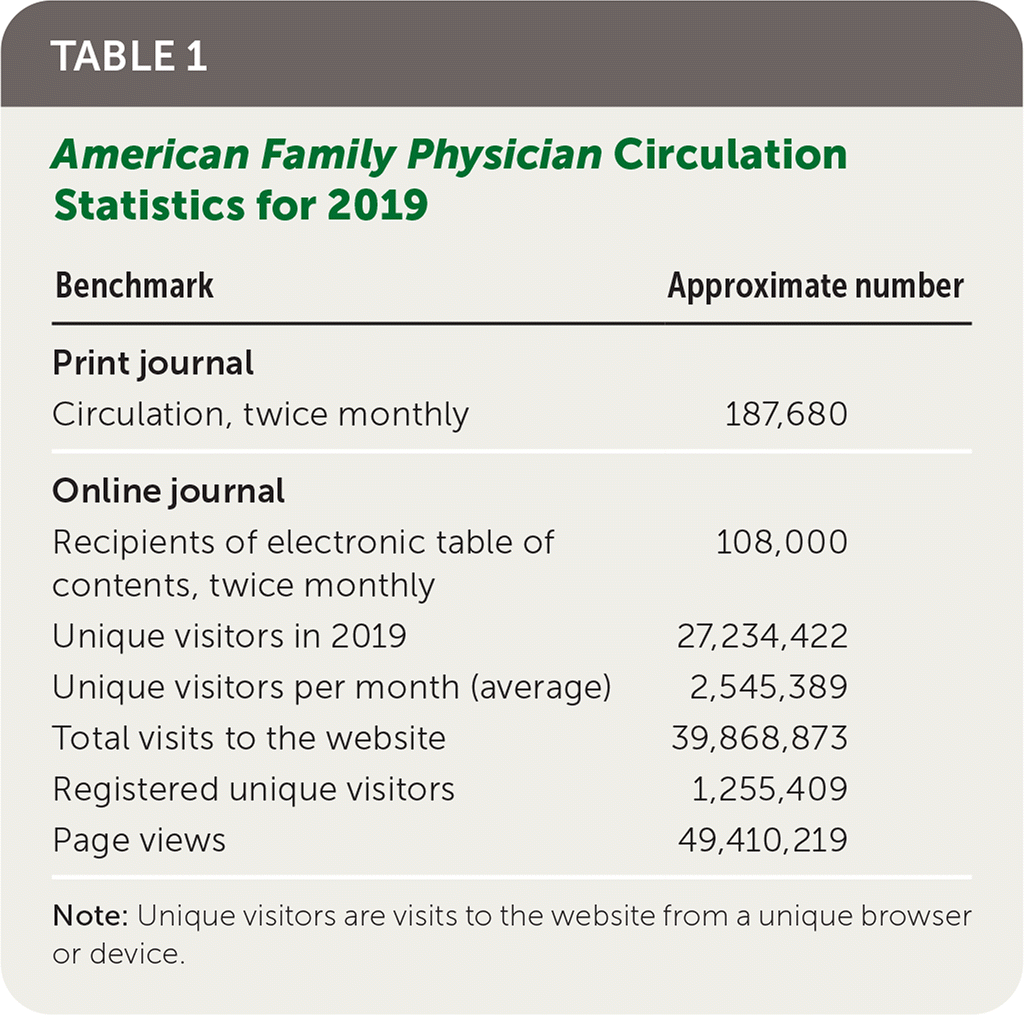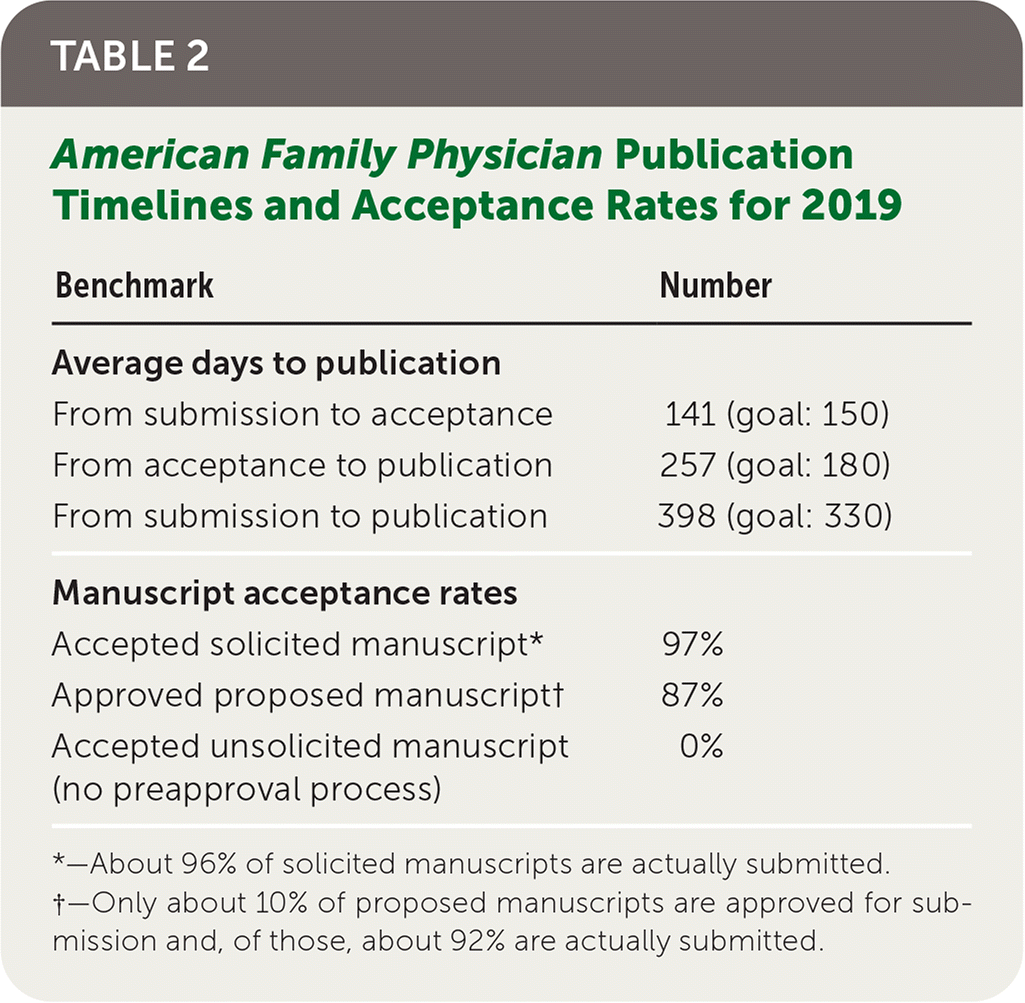
Am Fam Physician. 2020;102(8):457-459
Author disclosure: No relevant financial affiliations.
Describing the state of American Family Physician (AFP) in 2020, its 70th year of publication, can't be done without first acknowledging the dark shadow of the pandemic and emerging public awareness surrounding racial inequities. In these humbling times, AFP has made some positive changes, including our commitment to increase content related to systemic racism and health inequity. We've stepped outside of our usual editing processes to bring a collection of information related to coronavirus disease 2019 (COVID-19) to our website, and we've published more articles online ahead of print. We are also reviving a beloved department, Diary from a Week in Practice, which is now called Diary of a Family Physician, to foster a sense of camaraderie in primary care. We have two new Jay Siwek medical editing fellows and two patient partners on our Editorial Advisory Board. This editorial will also highlight the top 20 AFP articles of 2019, provide an update on AFP's statistics for print circulation and website visits, and thank our peer reviewers.1,2
Systemic Racism and Health Inequity
AFP is committed to reevaluating our curriculum and processes to better address racism and health inequities.3 Part of this commitment involves collaborating with editors across several other family medicine publications to share a common vision for our specialty and resources to help with this call to action. AFP's entire editing team endorsed an action plan, including this collaboration and other goals, that can be found on our website at https://www.aafp.org/journals/afp/content/diversity.html. Critical components of this plan include increasing content on racism, using more inclusive language, and convening a team focused on diversity, equity, and inclusion that is led by a dedicated AFP medical editor.
Jay Siwek Medical Editing Fellows
The AFP team welcomes two fellows this year, Dr. Joanna Drowos and Dr. Natasha Pyzocha. Each brings a unique background and skill set to the journal. Dr. Drowos is an associate professor of family medicine at the Charles E. Schmidt College of Medicine at Florida Atlantic University. She is also associate dean for faculty affairs and director for the Community and Preventive Medicine Clerkship. Dr. Pyzocha is currently a core physician for 98point6, a text-based virtual primary care service. She previously served in various clinician roles in Fort Carson, Colo. She completed a fellowship in wilderness medicine through the Wilderness Medical Society and serves as a physician volunteer for the U.S. Olympic Committee. You can read more about the new fellows' backgrounds and interests in the AFP Community Blog at https://afpjournal.blogspot.com/2020/09/introducing-2020-2021-afp-jay-siwek.html.
We will soon begin recruiting for the 2021 fellowship. You can read more about the application process at https://www.aafp.org/journals/afp/content/fellowship.html.
In addition to medical editing fellows, AFP also has resident and student representatives who help with various projects throughout the year. We thank Dr. Enkhee Tuvshintogs, who completed her residency at the Dignity Health Methodist Hospital of Sacramento Family Medicine Residency Program, where she was chief resident, and Dr. Libby Wetterer, who graduated from Georgetown University School of Medicine, for their valuable input this year. You can find more information about our resident and student representative programs at https://www.aafp.org/afp/residentrep and https://www.aafp.org/afp/studentrep.
New Content Features
AFP started producing content related to COVID-19 in early February via the community blog. This led to a series of blog posts followed by COVID-19 Daily Research Briefs and online-ahead-of-print editorials, articles, and letters to the editor, which have been compiled on our website at https://www.aafp.org/afp/COVID-19.html.
At the end of 2019, we sunsetted Close-ups, a department that ran in AFP for 12 years and highlighted stories from the patient perspective followed by a commentary from a family physician. Our next venture in sharing the personal side of medicine is to revisit the Diary from a Week in Practice department with a new name and approach. The first Diary of a Family Physician is in this issue of AFP and written by Drs. Annette Chavez and Seiji Hayashi. Dr. Chavez has been in practice for 32 years in the Dayton, Ohio, area with the past 19 years spent as a solo independent family physician at Carillon Family Practice. Dr. Hayashi has extensive experience in primary care leadership, quality improvement, and health policy at the local and national levels. He is currently the chief transformation officer and medical director at Mary's Center, a community health center in Washington, D.C., that provides health care, family literacy, and social services. For information on how to submit as a guest contributor to this department, see https://www.aafp.org/journals/afp/authors/guide/departments.html.
Although Lown Right Care: Reducing Overuse and Underuse is not a new department in AFP, we've added two new contributors who are also AFP's Patient Partners. Including patients in this collaborative way to inform clinical content is not yet common among medical journals. Our objective is to better align medical care with our patients' goals and values.4
AFP's Top 20 Articles of 2019
Don't miss the top 20 most viewed AFP articles on our website last year at https://www.aafp.org/journals/afp/explore/top-20-of-2019.html. The popular topics include treatment of the common cold, type 2 diabetes mellitus therapies, migraine headache prophylaxis, anticoagulation, patellofemoral pain syndrome, concussion, hand-foot-and-mouth disease, and several others, reflecting the broad scope of primary care. Our goal is to highlight all of these topics in AFP Clinical Answers (https://www.aafp.org/afp/answers).
Collections of the top 20 research studies for primary care physicians, the top 20 POEMs (Patient-Oriented Evidence that Matters), and the top 20 POEMs consistent with the principles of the Choosing Wisely Campaign, can be found at https://www.aafp.org/afp/toppoems.
Circulation and Website Statistics
The circulation of AFP's print journal is 187,680 (Table 1). To the best of our knowledge, this makes AFP's circulation the second highest among more than 5,000 peer-reviewed medical journals.5 Readership includes all 93,135 active members of the American Academy of Family Physicians (AAFP), approximately 40,000 nonmember family physicians, and approximately 50,000 general internists. AFP has consistently been rated the number one journal among primary care physicians.6

| Benchmark | Approximate number |
|---|---|
| Print journal | |
| Circulation, twice monthly | 187,680 |
| Online journal | |
| Recipients of electronic table of contents, twice monthly | 108,000 |
| Unique visitors in 2019 | 27,234,422 |
| Unique visitors per month (average) | 2,545,389 |
| Total visits to the website | 39,868,873 |
| Registered unique visitors | 1,255,409 |
| Page views | 49,410,219 |
In 2019, the AFP website received an average of 2.7 million unique visitors (i.e., from a unique browser or device) per month, making it one of the most popular online medical publications. This means that in addition to visits by almost all AAFP members, the website is viewed by millions of other health care professionals and others who presumably are seeking information about various clinical conditions. Additionally, about 480,000 of the journal's CME quizzes have been taken annually since 2017, and approximately 2.9 million credits were awarded in 2019.
Publication Timelines and Acceptance Rates
On average, review articles are accepted a little under five months after they are submitted, which allows time for peer review and medical editing (Table 2). Articles are typically published eight to nine months after acceptance. A lot goes into the selection of articles for each issue to provide readers with a mix of topics. Online-ahead-of-print articles are typically published online about four months after acceptance. In 2019, we published two articles online ahead of print, whereas we've already had nine in 2020.

| Benchmark | Number |
|---|---|
| Average days to publication | |
| From submission to acceptance | 141 (goal: 150) |
| From acceptance to publication | 257 (goal: 180) |
| From submission to publication | 398 (goal: 330) |
| Manuscript acceptance rates | |
| Accepted solicited manuscript* | 97% |
| Approved proposed manuscript† | 87% |
| Accepted unsolicited manuscript (no preapproval process) | 0% |
To ensure comprehensive coverage of a curriculum of topics, we solicit most of the articles that are published. We may ask a previous author to update their article, and we also circulate a “call for papers” through multiple family medicine communication platforms. Our preference is for the first author to be an experienced clinician and writer because our readership largely consists of busy physicians who rely on AFP for practical evidence-based content and CME. However, we encourage experienced authors to mentor less experienced coauthors, and we plan to promote a path for diverse coauthorship.
Authors who propose topics go through a formal approval process before submitting a manuscript for consideration, and they are strongly encouraged to read the AFP Authors' Guide (https://www.aafp.org/afp/authors) before contacting us. Roughly 12% of proposed topics are approved. Unapproved proposals are often not selected because the topic has already been covered or does not fit the AFP curriculum. For solicited and approved proposed topics, AFP editors provide authors with detailed guidance on the focus of the article before writing begins. For these reasons, the acceptance rate for solicited manuscripts and approved proposals is high at 95%.
Acknowledging Peer Reviewers
Peer review continues to be an essential and valuable process for AFP, and we are very appreciative of the work reviewers do in helping us develop sound content for our readers.1,7,8 This is the second year that we are highlighting peer reviewers who provided exceptional feedback and received high ratings on the reviews they provided, in addition to recognizing all of our peer reviewers for volunteering their time (https://www.aafp.org/journals/afp/reviewers/lists/2019.html). An archive of past AFP peer reviewers is available at https://www.aafp.org/journals/afp/reviewers/lists.html.
Not only is peer review critical to producing good content, but it is also an important part of learning how to analyze articles and improving one's own authorship skills. We dedicated a portion of our annual editors' meeting this summer to discuss ways to not only find good reviewers, but also ways to cultivate family physician expert reviewers. My hope is to continually improve our processes, enrich the skills of our current and future reviewers, and highlight more exceptional reviewers year after year.
If you are interested in reviewing for AFP, please visit the Reviewers' Guide at https://www.aafp.org/journals/afp/reviewers/guide.html. The AAFP has authorized CME credit for AAFP members who peer review manuscripts for the journal (https://www.aafp.org/credit-reporting/reporting/claim-credit). For new reviewers, we highly recommend that you find a mentor for your first review.
In summary, this has been an unparalleled year so far for many reasons, and I am truly thankful for the perseverance of our authors, editors, and reviewers who've kept AFP afloat and even more agile. As always, we welcome reader feedback to help us better meet your needs (afpjournal@aafp.org).
Editor's Note: Dr. Sexton is editor-in-chief of AFP.
